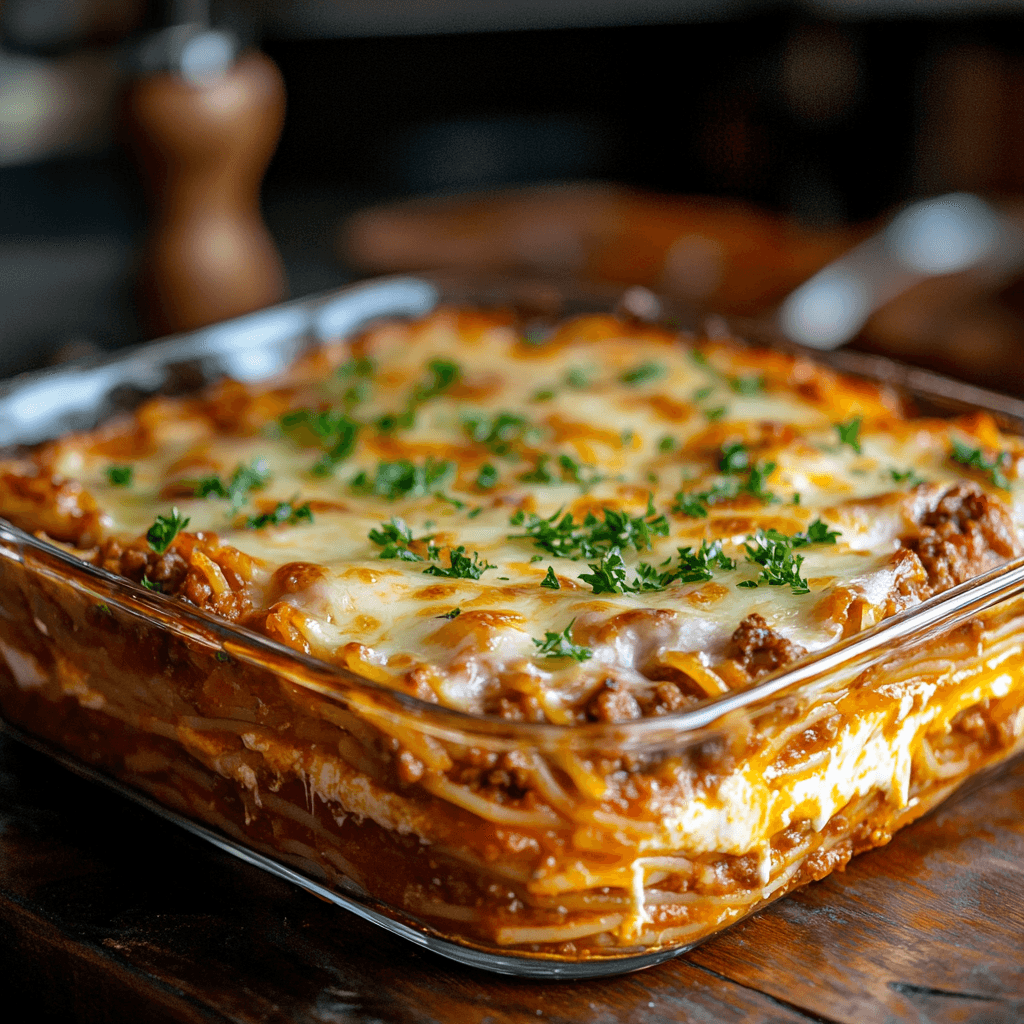During my firefighting days, potluck dinners were serious business. Everyone tried to bring something that would stand out among dozens of dishes, and that’s where I first encountered “millionaire spaghetti” – a dish so rich and indulgent it earned its extravagant name. What started as curiosity about unusual pasta names led me down a fascinating rabbit hole of creative pasta dishes that push traditional boundaries.
These aren’t your typical Italian classics, but rather American innovations and regional specialties that demonstrate how pasta adapts to different cultures and cooking styles. Each tells a story about creativity, resourcefulness, and the universal appeal of comfort food.
What is Millionaire Spaghetti?
Millionaire spaghetti is a layered pasta casserole that combines cooked spaghetti with a rich cream cheese mixture, meat sauce, and multiple types of melted cheese. The “millionaire” name refers to its incredibly rich, indulgent nature – it’s so loaded with expensive ingredients like cream cheese, sour cream, and premium cheeses that it feels luxurious.
The Structure of Millionaire Spaghetti: The dish builds in distinct layers: a bottom layer of spaghetti mixed with butter and cream cheese, a middle layer of seasoned ground beef in marinara sauce, and a top layer of mozzarella and cheddar cheese. When baked, these layers meld together while maintaining distinct textures and flavors.
The Secret Ingredient Philosophy: What makes millionaire spaghetti special isn’t any single secret ingredient, but rather the combination of multiple rich components that create complexity. The cream cheese layer adds tanginess and richness, the meat sauce provides savory depth, and the cheese blend creates that irresistible golden-brown top that defines comfort food casseroles.
The technique shares some principles with Gordon Ramsay’s layered pasta approaches, particularly the attention to distinct flavors that complement rather than compete with each other.
Cowboy Spaghetti: The Western Twist
Cowboy spaghetti earned its name from the hearty, ranch-style ingredients that could feed a hungry crew after a long day on the range. This dish combines ground beef, beans, corn, and bold seasonings like chili powder and cumin with traditional spaghetti.
The Cowboy Philosophy: This dish represents the American frontier approach to pasta – taking Italian techniques and adapting them with available ingredients and bold flavors. The beans add protein and fiber, the corn provides sweetness and texture, and the spice blend creates warmth that satisfied hard-working appetites.
Modern Cowboy Adaptations: Contemporary versions often include bell peppers, onions, and sometimes jalapeños for heat. The sauce typically combines tomato base with beef broth, creating a more substantial, stew-like consistency than traditional marinara.
The Mystery of Specialty Spaghetti Dishes
Beyond millionaire and cowboy spaghetti, several other creatively named pasta dishes have emerged from American kitchens, each with its own story and technique.
Princess Pasta: This elegant dish typically features angel hair pasta with a light cream sauce, often incorporating seafood like shrimp or scallops. The “princess” name reflects the delicate, refined presentation and lighter ingredients compared to heavier comfort food versions.
Scooby Doo Pasta: A kid-friendly creation that uses colorful pasta shapes (often the character-shaped varieties) with a simple cheese sauce or butter sauce. The name comes from the fun, cartoon-like appearance that appeals to children.
Wow Spaghetti: This exclamation-worthy dish varies by region but typically features an unexpected combination of ingredients that creates a “wow” factor – often involving unique sauce combinations or surprising ingredient additions like pineapple or unusual cheese blends.
The Secret Ingredient in Traditional Spaghetti
When people ask about “the secret ingredient in spaghetti,” they’re usually referring to one of several traditional Italian techniques that transform simple ingredients into extraordinary dishes.
Pasta Water as Liquid Gold: The most overlooked “secret ingredient” is the starchy pasta cooking water. Professional chefs consider this essential for creating silky sauces that cling properly to pasta. The dissolved starches act as natural emulsifiers, binding oil and water-based ingredients together.
Parmigiano-Reggiano Rinds: Many traditional recipes include Parmigiano-Reggiano rinds simmered in tomato sauce. These rinds add deep, savory umami flavor without the expense of using large amounts of fresh cheese. They’re removed before serving but leave behind complex flavor notes.
The Anchovy Foundation: Even in non-seafood dishes, many Italian cooks add one or two anchovy fillets to their tomato sauce. They dissolve completely during cooking, adding depth and saltiness without any fishy flavor. This technique appears in many traditional ragu recipes.
Understanding professional pasta sauce techniques reveals how these “secret” ingredients work to create restaurant-quality results at home.
Regional American Pasta Innovations
Rosetta Spaghetti: This dish typically features a rose-colored sauce created by combining tomato and cream sauces. The name “rosetta” refers to the pinkish color that results from this combination. It often includes Italian sausage or chicken and represents the American tendency to combine Italian techniques with richer, creamier flavors.
Audrey Hepburn Spaghetti: Named after the actress’s famous scene in “Roman Holiday,” this dish usually features a simple, elegant preparation – often aglio e olio (garlic and oil) or a light tomato sauce with fresh basil. The name reflects the sophistication and classic simplicity associated with the iconic actress.
Spooky Spaghetti: A Halloween-themed creation that uses black pasta (often colored with squid ink) or regular pasta with a dark sauce, sometimes incorporating blackened ingredients or dramatic presentation elements. It’s more about visual impact than specific flavor profiles.
The Science Behind Creative Pasta Combinations
What makes these creative pasta dishes work isn’t just novelty – it’s understanding how different ingredients complement each other and how traditional techniques adapt to new flavor combinations.
Sauce Adhesion Principles: Whether you’re making millionaire spaghetti or cowboy pasta, the same principles apply: matching sauce consistency to pasta shape, ensuring proper seasoning at each layer, and understanding how different fats (butter, cream cheese, olive oil) affect texture and flavor.
Flavor Layering Techniques: Successful creative pasta dishes build flavors in layers, just like traditional Italian cooking. The base layer provides foundation flavors, middle layers add complexity, and finishing touches provide brightness or richness.
Texture Contrast Strategy: The best pasta dishes incorporate multiple textures – smooth sauces, al dente pasta, crispy cheese tops, or crunchy additions. This textural variety keeps each bite interesting and prevents palate fatigue.
Professional cooking resources like America’s Test Kitchen pasta guides demonstrate how these fundamental principles apply regardless of whether you’re making traditional Italian dishes or modern American innovations.
Adapting Creative Recipes for Success
Balancing Richness: Dishes like millionaire spaghetti can become overwhelmingly heavy if not properly balanced. Adding acidic elements (tomatoes, wine, or lemon) and fresh herbs helps cut through richness and maintains palate interest.
Scaling Seasoning: Creative pasta dishes often combine multiple seasoned components. Taste each element separately and adjust seasoning at each stage rather than trying to fix everything at the end.
Managing Moisture: Layered pasta dishes can become watery if not properly managed. Pre-cooking vegetables to remove excess moisture, using thick sauces, and proper cheese selection all contribute to successful results.
The key to success with any of these creative pasta dishes is understanding that innovation works best when built on solid fundamental techniques. Whether you’re making Gordon Ramsay’s classic preparations or experimenting with millionaire spaghetti, the same attention to ingredient quality, proper seasoning, and technique execution determines the final results.
Making Creative Pasta Dishes Your Own
Start with Quality Basics: Even the most creative pasta dish benefits from proper pasta cooking technique, quality ingredients, and attention to seasoning. Master the fundamentals before adding creative elements.
Test Flavor Combinations: Before committing to a full recipe, test flavor combinations in small batches. Some ingredient pairings that sound interesting don’t work in practice, while others create surprisingly delicious results.
Document Your Successes: When you create a winning combination, write down exact measurements and techniques. Creative cooking often involves improvisation, but successful dishes need to be reproducible.
These creative pasta dishes represent the American spirit of innovation and adaptation. They take traditional techniques and reimagine them for different tastes, occasions, and available ingredients. While they may not have centuries of tradition behind them, they demonstrate how food evolves and how creativity can produce genuinely delicious results.
For cooks interested in exploring both traditional and innovative approaches, understanding common pasta cooking mistakes provides the foundation needed to execute any pasta dish successfully, whether it’s a classic Italian preparation or a modern American creation.
The most important lesson from these creative dishes is that good cooking principles transcend specific recipes. Whether you’re making millionaire spaghetti or cacio e pepe, success comes from understanding ingredients, respecting techniques, and paying attention to the details that separate amateur results from professional-quality dishes.
Stay safe,



